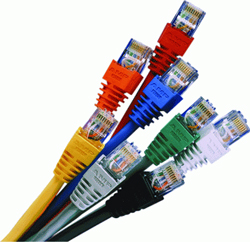By John Shepler
There are many types of broadband internet connections, including DSL, cellular, wireless, cable, satellite, and various fiber optic options. Each has pros and cons regarding cost and performance. However, one technology stands out as the best fit for most businesses: the combination of internet and Ethernet.
Ethernet’s dominance in wired networks, both big and small, is its biggest strength. It’s the standard protocol for Local Area Networks (LANs), making it compatible with almost all network equipment. This widespread use translates to lower costs and easy availability of components like cables, connectors, and routers.
The One Laggard… The WAN
While Ethernet rules LANs, Wide Area Networks (WANs) are a different story. Developed with different standards by telephone companies, WANs were initially designed for analog phone systems, not computers. This led to the creation of digital standards like T1 and fiber optic systems, which used different protocols than Ethernet. Consequently, connecting Ethernet networks to these systems required protocol conversion, a practice that persists in traditional telecom networks, although it’s rapidly changing.
Carrier Ethernet Moves to the Front
As network technology advanced, switched Ethernet emerged, replacing older systems. This paved the way for Carrier Ethernet, an extension of LAN Ethernet designed for long-distance networks. With Carrier Ethernet, the need for protocol conversion is eliminated, allowing data packets to travel seamlessly across long distances.
Ethernet and the Internet
The internet, built on the Internet Protocol (IP), was initially reliant on existing telephone company infrastructure and standards like SONET fiber optic. However, Ethernet is now becoming central to many networks. Modern network providers are increasingly building their systems around IP, reducing reliance on traditional telephone company systems.
Ethernet’s Big Advantages
Carrier Ethernet offers flexible speeds while adhering to the Ethernet standard. Users can choose their maximum desired speed, typically starting with lower speeds like 10 or 100 Mbps and upgrading to Gigabit Ethernet or higher as their needs grow. This scalability allows businesses to only pay for the bandwidth they require.
Compared to traditional telecom services, Ethernet services often provide more bandwidth at the same or lower cost. For instance, 3 Mbps Ethernet might cost the same as a 1.5 Mbps T1 line. Additionally, dedicated Ethernet Internet access ensures symmetrical bandwidth, meaning equal upload and download speeds. Unlike shared bandwidth services like cable or cellular, dedicated bandwidth guarantees consistent performance regardless of other users.
Ordering Ethernet Internet Service
Bandwidth brokers, like Telarus, are a great resource for businesses seeking broadband services. They work with multiple carriers, providing a range of options, typically Ethernet over Copper for lower speeds and Ethernet over Fiber for 50 Mbps and up. While fiber is ideal for buildings with existing infrastructure, copper-based solutions offer a widely available alternative.
Interested in exploring available options and costs? Conduct a quick search for fiber optic Ethernet service here and see what you find.


